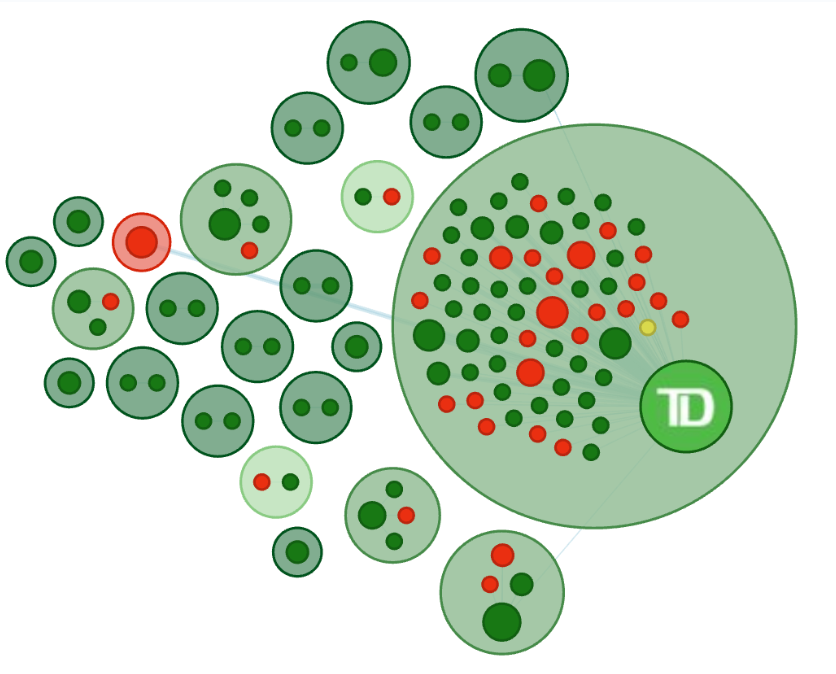With 27 million customers worldwide and over 1,900 branches, TD Bank is one of the largest in North America. In recent months, TD Bank has faced a major crisis, which included pleading guilty to U.S. money-laundering violations, paying over $3B in fines, and facing strict growth limits. The scandal led to its first quarterly loss in 20 years, branch closures, cost cuts, and thousands of job reductions while severely damaging its reputation.
But the reputational and financial crisis became far worse when disinformation attached itself to the public discourse surrounding TD Bank. Harmful narratives, many of them false and misleading, amplified the outrage, turning existing criticism into coordinated attacks that spread rapidly across social media. What began as a scandal evolved into a full-scale reputational assault, significantly amplifying the damage to the bank’s brand.
TL;DR?
- 24% of accounts discussing TD Bank on X were fake, and were posting harmful content directly in comment sections of TD Bank’s official X and Facebook accounts
- This sophisticated tactic ensured negative messaging appeared prominently to followers and potential customers, effectively hijacking the bank’s communication channels
- Four negative narratives dominated the conversation, amplified by fake profiles: financial misconduct allegations, claims of account freezes during protests, claims of government collusion, and viral fraud reports
A Reputation Under Coordinated Attack
Negative discourse around TD Bank started trending in July and quickly blew into a significant reputation crisis. Cyabra uncovered that much of this crisis was fueled by inauthentic activity across social media, revealing a sophisticated digital reputation attack that amplified damaging narratives.
The analysis found that while 26% of the posts were expressing negative sentiment toward TD Bank, with conversations linking the bank to corruption and financial misconduct, nearly a quarter of the accounts participating in these discussions (24%) were actually fake. These profiles mostly posted directly on the bank’s official social media accounts to maximize visibility as they amplified damaging and toxic narratives.
The Numbers Behind the Crisis
Cyabra’s analysis revealed stark metrics of manipulation:
- 24% of profiles discussing TD Bank on X were fake accounts – significantly exceeding the typical 7-10% benchmark
- Inauthentic accounts repeatedly portrayed the bank as untrustworthy, accusing it of money laundering, and warning the public against using TD Bank’s services
- Negative content from these fake profiles received over 190 engagements with a potential reach of 90,000 views
These fake accounts strategically inserted themselves into existing conversations, amplifying harmful claims already circulating and giving them greater perceived legitimacy.

Strategic Targeting Tactics
Cyabra’s investigation uncovered calculated targeting strategies designed to maximize damage. Fake accounts deliberately focused on the bank’s owned social channels rather than just participating in general discussions.
A key tactic involved posting harmful content directly in the comment sections of TD Bank’s official X and Facebook accounts. This ensured negative messaging appeared prominently to followers and potential customers, effectively hijacking the bank’s communication channels.
Cyabra identified clusters of fake profiles interacting with TD Bank’s accounts in coordinated patterns, creating an impression of widespread consensus around negative opinions. These inauthentic accounts skillfully integrated their messaging with legitimate customer complaints, blurring the line between genuine dissatisfaction and manufactured outrage.

Four Narrative Pillars of the Attack
The investigation identified four primary narratives dominating the negative discourse:
- Financial misconduct allegations: The most prominent narrative accused TD Bank of involvement in money laundering and financing criminal activity. Posts used emotional messaging while framing the bank as knowingly enabling these activities.
- Account freezes during Freedom Convoy protests: Numerous posts referenced TD Bank’s freezing of accounts during Canada’s Freedom Convoy protests, portraying the actions as punitive and connecting banking policies to political tensions.
- Government collusion claims: Some narratives framed TD Bank as complicit in government overreach, positioning the bank as an agent of state control rather than a service provider.
- Customer fraud reports: Multiple posts shared accounts of scam attempts impersonating TD Bank, ATM skimming, and fraudulent charges. While some reflected genuine experiences, the volume and timing suggested coordinated amplification.
The reinforcement of these narratives across multiple accounts created a perception of widespread rage towards TD Bank, despite a significant portion coming from inauthentic sources.
Implications for Financial Communications Teams
The TD Bank case highlights critical considerations for financial institutions:
- Accelerated reputation crises: Inauthentic accounts create the illusion of widespread outrage, which, if not properly identified, can trigger real stakeholder concerns.
- Vulnerability of owned channels: Brand-owned social channels provide direct access to core stakeholders, making them prime targets for coordinated attacks.
- Early warning indicators: The unusually high percentage of fake accounts (24% vs. typical 7-10%) serves as an early warning sign. Financial teams should establish baseline authenticity metrics to quickly identify unusual patterns.
- Narrative manipulations: Understanding specific harmful and toxic narratives that are being amplified provides crucial context for response strategies.

Protecting Financial Brand Reputation
Financial institutions can take proactive steps against coordinated reputation attacks:
- Continuous authenticity monitoring: Implement monitoring of brand conversations with attention to authenticity metrics. Unusual spikes in fake account activity should trigger enhanced scrutiny.
- Official channel protection: Develop protocols for monitoring and moderating official brand channels during crisis periods.
- Proportionate response strategies: Incorporate authenticity analysis into crisis response to prevent overreaction to manufactured outrage while addressing genuine concerns.
- Cross-platform coordination: Monitor for coordinated narrative patterns across multiple platforms – often, similar messaging would appear on different platforms by different profiles (in TD Bank’s case, similar posts appear both on X and on Facebook).
TD Bank’s case demonstrates how sophisticated actors leverage brand crises to amplify negative narratives and bot networks, thereby accelerating reputation damage. By understanding their tactics and implementing appropriate monitoring strategies, financial institutions can better protect their brands against coordinated attacks.


